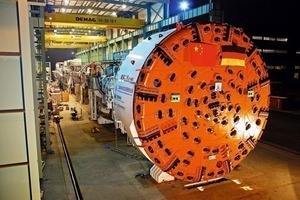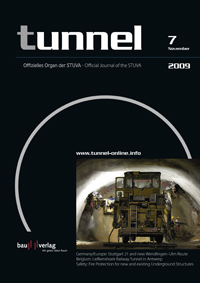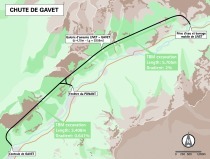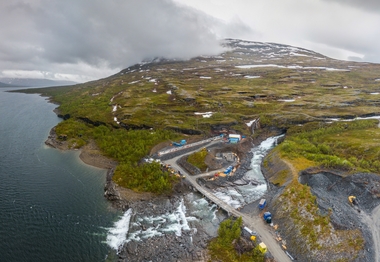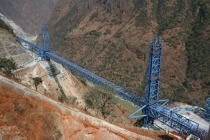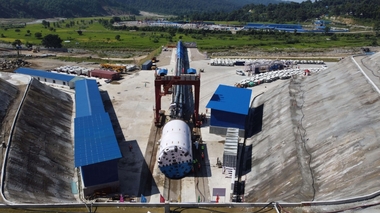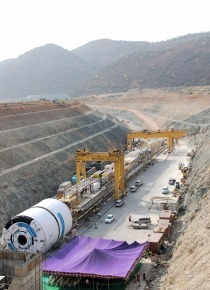Jinping II: Gripper TBM for Hydro-Power Plant
The Jinping II is being built in Sichuan Province in Central China. It is intended to generate 4,800 MW upon completion. Four water diversion tunnels lead through high-strength rock with high overburdens. Tunnelling is carried out both by mechanised means as well as drill+blast.
At present the 2 power plant stages Jinping I and Jinping II are being constructed on the Yalong River, one of the main tributaries on the upper reaches of the Yangtze, in the Chinese province of Sichuan. The project has been commissioned by the Ertan Hydropower Develop-ment Co. (EHDC). It is planned that the Jinping II on the lower reaches of the river will generate a total of 4,800 MW thus making it the hydropower plant with the highest capacity among the 5 along the Yalong.
Jinping II represents part of a scheme to exploit capacities for producing power in West and Central China in order to cover the increasing demand that has risen in recent years in the economically strong eastern part of the country. The power plant will also enable to help meet energy requirements in Sichuan and Chongqing provinces.
The route of the 4 water diversion tunnels with an excavated diameter of 12.4 m was planned in such a way that they take advantage of a 150 km long bend in the Yalong River in order to exploit the difference in height between the arms of the loop to generate energy. The power plant’s height of fall amounts to 318 m.
Two of these water diversion tunnels are being driven by mechanised tunnelling and
2 via drill+blast. Currently diversion tunnel No. 1 is being bored by a Main Beam TBM supplied by Robbins. A Herrenknecht Gripper TBM is in action for diversion tunnel No. 3 for the Jinping II project. Both TBMs possess 12.4 m bore diameter.
The Gripper TBM S-405 from Herrenknecht complete with trailers for diversion tunnel No. 3 was commissioned by the Ertan Hydropower Development Co. Ltd. (EGDC) and is being employed by a Joint Venture constituting the China Railway 13th Bureau Group Ltd. and the Beijing Vibroflotation Engineer-ing Co. Ltd. This Gripper machine for diversion tunnel No. 3 is focused on in this report
(Fig. 1).
In the area a “road access tunnel” and a 5 km long exploratory tunnel have been produced. The geological-geotechnical data obtained in the project zone are mainly based on surface charts as well as findings received from the drill+blast operations carried out for the existing tunnels.
Geological Situation
The route in the project zone for the Jinping II hydropower station runs at a height of
1,600 m ASL and is 16 km long given overburdens ranging from 1,270 to 2,525 m. The geology along the tunnel to be produced through the Jinping range of mountains – with heights of up to 4,300 m – mainly consists of medium to thick beds of lime marble with compressive strengths extending up to 150 MPa. Rock bursts were observed in the massive marble in reference projects as from approx. 1,700 m overburden. In the case of the TBM drive these phenomena can be reckoned with even given shallower overburdens in the massive, thick-bedded limes, where there is also ingressing water. So far during the Gripper TBM drive in Jinping rock destressing has only occurred in front of the cutterhead. Up till now there have not been rock bursts or cases of ingressing water.
On account of the high rock overburden an unstable face has to be reckoned with over an extremely large part of the tunnel owing to stress redistribution, i.e. the collapsing of dense sequences of bedding. This is encouraged by the upright structure of the marble. Fur-thermore karstification with a high incidence of water has to be reckoned with on account of the largely limey rock that prevails. In this connection the karst mostly appears to be associated with fissured crack systems.
The geological-geotechnical subsoil conditions for the mechanised drive that were forecast for the Jinping project are very complex to describe. The engineering challenges relate to the high in situ rock pressure, rock bursts, karst deposits, high water inbursts, high temperatures as well as dangerous gases, which are toxic (hydrogen sulphide H2S). These conditions formed the basis for the dimensioning and design of the hard rock TBM that is being used. The cutterhead design was primarily governed by the risk of rock bursts as well as the high amount of ingressing water that was expected.
Applied Engineering
The TBM applied for the 16 km long water diversion tunnel corresponds to the latest state of the art for mechanised tunnelling technology in hard rock and was targeted for the requirements posed by the Jinping project (Fig. 2). The hard rock cutterhead of the S-405 possesses a diameter of 12.44 m and is fitted with 19” roller cutters (73 single-ring roller cutters and 4 two-ring roller cutters). The cutterhead has 12 openings for material in its outer area and 4 in its central area.
The cutter wheel with speeds of up to 5 rpm is provided with 4,900 kW driving output. The torque amounts to 19,750 kNm and the thrusting force is 39,584 kN. The cutter wheel consists of a central segment and 4 outer ones. In order to be able to react to possible convergences, overcutting at the cutter wheel is possible through shifting the roller cutters.
Stress redistributions in the rock can lead to an unstable face. In this connection systematic crumbling of the face is to be reckoned with. These findings were obtained both at the Lötschberg as well as Gotthard Base Tunnels (Amsteg and Bodio contract sections) in Switzerland. The cutting wheel design for the Jinping project has been adapted to such conditions. Very big and massive blocks of rock can be broken by the cutterhead, i.e. by the roller cutters, diverters, buckets and spokes in the openings. However, compared to the Swiss projects just mentioned the rock to be found in the Jinping project is not quite so hard or abrasive.
For the event that large quantities of water emerge from the face the cutterhead’s bucket channels must be designed in such a manner that the water can be disposed of in a controlled as possible fashion, i.e. that it can be separated from the removed rock. Perforated plates in the bucket channels fulfil this task. Furthermore there are openings on the rear side of the cutterhead to allow water to escape. Both structures are intended to drain the water-saturated material prior to it dropping on to the muck ring. The water is then diverted to the cutterhead’s base area and then along the floor segments in the TBM area. The back-up system has been devised in such a way that its lower edge lies 1.68 m above the tunnel floor. The hard rock machine is provided with 3 large drainage pumps each of 300 m³/h capacity, which are intended to keep the trackbound installation dry.
Two drilling units each for anchor and umbrella bores are arranged in the L1 and L2 zones of the machine. Two double cutterhead units are set in the TBM’s L2 zone above and below the machine frame. They can be used to undertake trial bores. The shotcrete for the final tunnel support is installed with the aid of an automatic spraying robot assembled on the trailer’s bridge structure and the 5th trailer.
The material removed at the face is continuously transported via a machine belt and subsequently with a tunnel conveyor belt to the tunnel portal. The capacity of the conveyor belt is geared to the maximum rate of advance. A VTM GmbH control system is installed on the TBM.
Herrenknecht’s Gripper TBM with 12.4 m diameter for the roughly 16 km long water diversion tunnel for the Jinping II hydropower plant has been functioning since mid-November 2008 (Fig. 3). Regular working times amount to 7 days per week with 11 hours worked per day. By the start of September 2009 the tunnelling machine had bored and secured 1,724 m. The best daily rate of 30 m was achieved on July 20th, 2009.
Outlook
With 12.40 m diameter the S-405 for the Jinping II project is the biggest Gripper TBM that Herrenknecht has ever supplied. It is devised to master the special challenges of the project as capably as possible: stress redistributions in the rock, high rock overburden as well as the risk of extremely high inflows of water. With the completion of the Jinping II major project and the opening of the power plant a further opportunity will arise for providing a part of the Chinese economic explosion with environmentally-friendly hydropower.

